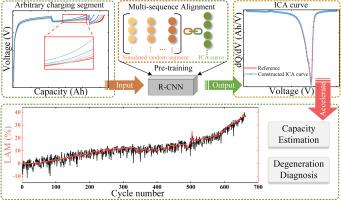Unlocking minute-level battery incremental capacity analysis construction using deep learning and multi-sequence alignment
IF 11
1区 工程技术
Q1 ENERGY & FUELS
引用次数: 0
Abstract
Incremental capacity analysis (ICA) is crucial for accurate, non-destructive lithium-ion battery degradation diagnosis, particularly for loss-sensitive electric vehicle (EV) applications. However, conventional ICA requires low-current charging over several hours, making it impractical under the EVs' multi-stage fast-charging conditions. Thus, this work unlocks a minute-level ICA construction framework for non-destructive mechanism diagnosis using stochastic charging segments. The multi-sequence alignment technique establishes the equivalent match between partial voltage segments and the ICA curve to eliminate conventional ICA data collection constraints. A residual-based convolutional neural network (R-CNN) is developed to achieve rapid and accurate ICA curve construction through feature fusion. Results demonstrate that 30 points collected within 5 min (starting from an arbitrary initial capacity) are sufficient for reliable ICA curve construction with the average mean absolute error (MAE) less than 0.061 Ah/V, and the average absolute percentage error (APE) less than 7.734 % for ICA peak estimation. The robustness of the proposed method under different working conditions has been verified. Through transfer learning, it is possible to adapt the pre-trained model to multiple fast-charging policies. Furthermore, the quantitative degradation mechanism from the rapidly constructed ICA curves facilitates practical electrode-level non-destructive battery diagnostics. This work can provide new perspectives for the characterization of battery degradation under fast-charging conditions.

使用深度学习和多序列对齐解锁分钟级电池增量容量分析构建
增量容量分析(ICA)对于准确、非破坏性的锂离子电池退化诊断至关重要,特别是对于损耗敏感型电动汽车(EV)应用。然而,传统的ICA需要在几个小时内进行低电流充电,这在电动汽车的多阶段快速充电条件下是不切实际的。因此,这项工作解锁了一个分钟级的ICA构建框架,用于使用随机充电段进行非破坏性机制诊断。多序列比对技术在局部电压段与ICA曲线之间建立等效匹配,消除了传统ICA数据采集的约束。提出了一种基于残差的卷积神经网络(R-CNN),通过特征融合实现快速准确的ICA曲线构建。结果表明,在5 min内(从任意初始容量开始)采集的30个点足以可靠地构建ICA曲线,ICA峰值估计的平均平均绝对误差(MAE)小于0.061 Ah/V,平均绝对百分比误差(APE)小于7.734%。验证了该方法在不同工况下的鲁棒性。通过迁移学习,可以使预训练模型适应多种快速充电策略。此外,快速构建的ICA曲线的定量退化机制有助于实际的电极级无损电池诊断。这项工作为快速充电条件下电池退化的表征提供了新的视角。
本文章由计算机程序翻译,如有差异,请以英文原文为准。
求助全文
约1分钟内获得全文
求助全文
来源期刊

Applied Energy
工程技术-工程:化工
CiteScore
21.20
自引率
10.70%
发文量
1830
审稿时长
41 days
期刊介绍:
Applied Energy serves as a platform for sharing innovations, research, development, and demonstrations in energy conversion, conservation, and sustainable energy systems. The journal covers topics such as optimal energy resource use, environmental pollutant mitigation, and energy process analysis. It welcomes original papers, review articles, technical notes, and letters to the editor. Authors are encouraged to submit manuscripts that bridge the gap between research, development, and implementation. The journal addresses a wide spectrum of topics, including fossil and renewable energy technologies, energy economics, and environmental impacts. Applied Energy also explores modeling and forecasting, conservation strategies, and the social and economic implications of energy policies, including climate change mitigation. It is complemented by the open-access journal Advances in Applied Energy.
 求助内容:
求助内容: 应助结果提醒方式:
应助结果提醒方式:


